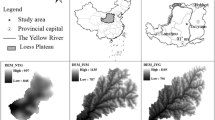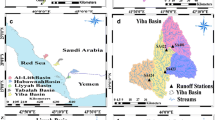Abstract
The available antecedent moisture condition (AMC)-dependent runoff curve number (CN) (SCS, National Engineering Handbook, Supplement A, Section 4, Chapter 10, Soil Conservation Service, USDA, Washington, DC, 1956) conversion formulae due to Sobhani (M.S. Thesis, Utah State University, Logan, UT, 1975), Hawkins et al. (J Irrig Drain Eng, ASCE 111:330–340, 1985), Chow et al. (McGraw-Hill, New York, 1988), and Neitsch et al. (Texas Water Resources Institute, College Station, TX, TWRI Report TR-191, 2002) were compared utilizing the NEH-4 CN-values (SCS, National Engineering Handbook, Supplement A, Section 4, Chapter 10, Soil Conservation Service, USDA, Washington, DC, 1972) as target values. The Sobhani formula was found to perform the best in CNI-conversion, and the Hawkins formula in CNIII-conversion. When evaluated on a large set of Agriculture Research Service (United States) data, a newly proposed formula performed the best of all, and the Neitsch formula the poorest, and therefore, the former was recommended for field use. The poorest performance of the latter is largely attributed to the occurrence of unreasonable negative CNI-values at low CNII-values.
Similar content being viewed by others
References
Bales J, Betson RP (1981) The curve number as a hydrologic index. In: Proc., int. symp. on rainfall–runoff modeling. Water Resources Publications, Littleton, CO, pp 371–386
Beasley DB, Huggins LF, Monke EJ (1980) ANSWERS: a model for watershed planning. Trans ASAE 23:938–944
Chow VT, Maidment DR, Mays LW (1988) Applied hydrology. McGraw-Hill, New York
Hawkins RH (1978) Runoff curve number with varying site moisture. J Irrig Drain Eng 104(4):389–398
Hawkins RH (1993) Asymptotic determination of runoff curve numbers from data. J Irrig Drain Eng ASCE 119(2):334–345
Hawkins RH (1996) Discussion of “SCS runoff equation revisited for variable–source runoff areas” by Steenhuis T.S., Winchell M., Rossing J., Zollweg J.A. and Walter M.F. J Irrig Drain Eng ASCE 122(5):319–320
Hawkins RH (2005) Personal communications on SCS-CN model. Received via email.
Hawkins RH, Hjelmfelt AT Jr, Zevenbergen AW (1985) Runoff probability, storm depth and curve numbers. J Irrig Drain Eng ASCE 111(4):330–340
Hawkins RH, Jiang R, Woodward DE, Hjelmfelt AT Jr, Mullem VJA (2002) Runoff curve number method: examination of the Initial abstraction ratio. www.wcc.nrcs.usda.gov/water/quality/common/techpapers/curve.html. Second Federal Interagency Hydrologic Modeling Conference, Las Vegas, NV
Hjelmfelt AT Jr (1991) Investigation of curve number procedure. J Hydraul Eng ASCE 117(6):725–737
Hjelmfelt AT Jr, Kramer LA, Burwell RE (1981) Curve number as random variable. In: Singh VP (ed) Proc., int. symp. on rainfall–runoff modeling. Water Resources Publications, Littleton, CO, pp 365–370
Hjelmfelt AT, Woodward DE, Conaway G, Quan QD, Mullem VJA, Hawkins RH (2001) Curve numbers, recent development. IAHR, 29th IAHR Congress Proceedings, Beijing, China, pp 285–291
Hope AS, Schulze RE (1981) Improved estimates of storm flow volume using the SCS CN method. In: Singh VP (ed) Proc., int. symp. on rainfall–runoff modeling. Water Resources Publications, Littleton, CO, pp 419–428
Hydrologic Engineering Center (HEC) (1981) HEC-1 flood hydrograph package: users manual. US Army Corps of Engineers, Davis, CA
McCuen RH (2002) Approach to confidence interval estimation for curve numbers. J Hydrol Eng 7(1):43–48
Metcalf and Eddy, Inc., Univ. of Florida, and Water Resources Engineers, Inc. (1971) Storm water management model, Vol. 1 – Final report. EPA Rep. No. 11024DOC07/71 (NITS PB-203289), EPA, Washington, DC
Mishra SK, Singh VP (2003) Soil conservation service curve number (SCS-CN) methodology. Kluwer, Dordrecht, The Netherlands ISBN 1-4020-1132-6
Mishra SK, Jain MK, Pandey RP, Singh VP (2005) Catchment area-based evaluation of the AMC-dependent SCS-CN-based rainfall–runoff models. Hydrol Process 19(14):2701–2718
Mullem VJ, Woodward DE, Hawkins RH, Hjelmfelt AT Jr (2002) Runoff curve number method: beyond the handbook. Second Federal Interagency Hydrologic Modeling Conference, Las Vegas, NV, pp 1–10
Natale L, Todini E (1977) A constrained parameter estimation technique for linear models in hydrology. In: Ciriani TA, Maione U, Wallis JR (eds) Mathematical models of surface water hydrology. Wiley, London, pp 109–147
Neitsch SL, Arnold JG, Kiniry JR, Williams JR, King KW (2002) Soil and water assessment tool (SWAT): theoretical documentation, version 2000. Texas Water Resources Institute, College Station, TX, TWRI Report TR-191
Ponce VM, Hawkins RH (1996) Runoff curve number: has it reached maturity? J Hydrol Eng ASCE 1(1):11–19
Schneider LE, McCuen RH (2005) Statistical guidelines for curve number generation. J Irrig Drain Eng ASCE 131(3):282–290
SCS (1956) Hydrology. National Engineering Handbook, Supplement A, Section 4, Chapter 10, Soil Conservation Service, USDA, Washington, DC
SCS (1964) Hydrology. National Engineering Handbook, Supplement A, Section 4, Chapter 10, Soil Conservation Service, USDA, Washington, DC
SCS (1971) Hydrology. National Engineering Handbook, Supplement A, Section 4, Chapter 10, Soil Conservation Service, USDA, Washington, DC
SCS (1972) Hydrology. National Engineering Handbook, Supplement A, Section 4, Chapter 10, Soil Conservation Service, USDA, Washington, DC
SCS (1985) Hydrology. National Engineering Handbook, Supplement A, Section 4, Chapter 10, Soil Conservation Service, USDA, Washington, DC
SCS (1993) Hydrology. National Engineering Handbook, Supplement A, Section 4, Chapter 10, Soil Conservation Service, USDA, Washington, DC
Smith RE, Williams JR (1980) Simulation of surface water hydrology. In: Knisel WG (ed) CREAMS: a field-scale model for chemicals, runoff, and erosion from agricultural management systems. U.S. Department of Agriculture, Science and Education Administration, Conservation Research Report No. 26, Vol. I, Chapter 2, pp 13–35
Sobhani G (1975) A review of selected small watershed design methods for possible adoption to Iranian conditions. M.S. Thesis, Utah State University, Logan, UT
SPSS (2000) Automated curve fitting and equation discovery software. TableCurve 2D v5 for Windows, Distributor: SPSS Science Software GmbH, Germany, web site: http://www.spssscience.com/
Williams JR, LaSeur WV (1976) Water yield model using SCS curve numbers. J Hydraul Div ASCE 102(HY9):1241–1253
Young RA, Onstad CA, Bosch DD (1995) Chapter 26: AGNPS: an agricultural nonpoint source model. In: Singh VP (ed) Computer models of watershed hydrology. Water Resources Publications, Littleton, CO
Author information
Authors and Affiliations
Corresponding author
Rights and permissions
About this article
Cite this article
Mishra, S.K., Jain, M.K., Suresh Babu, P. et al. Comparison of AMC-dependent CN-conversion Formulae. Water Resour Manage 22, 1409–1420 (2008). https://doi.org/10.1007/s11269-007-9233-5
Received:
Accepted:
Published:
Issue Date:
DOI: https://doi.org/10.1007/s11269-007-9233-5




